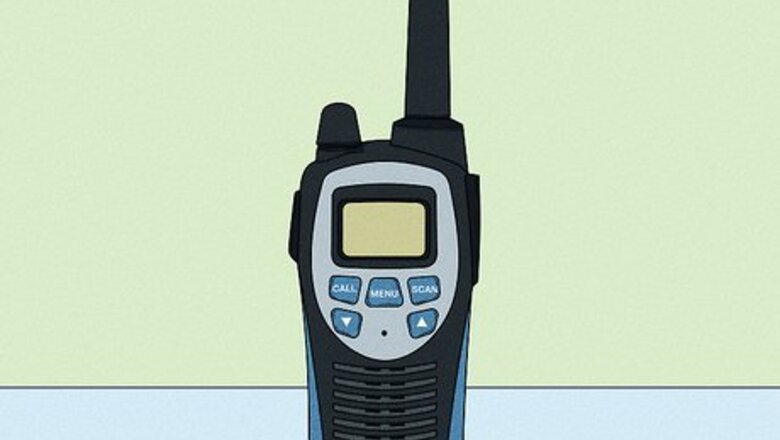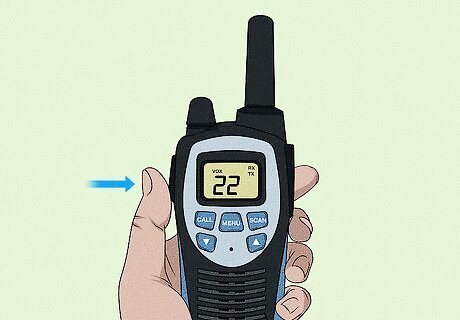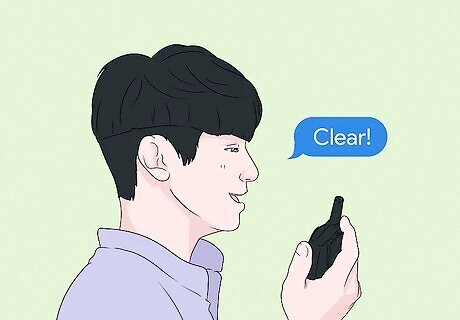
views
Operating a UHF Radio

Choose a radio tuned to public "Ultra-high frequencies" (or UHF) frequencies. UHF is a large portion of radio spectrum from 300 MHz to 3 GHz, but specific bands (groups) of frequencies in it are available for public use, roughly in the 460 to 480 MHz range, depending on where you live. Check the labeling on the packaging before purchase. Most UHF devices, including handheld radios, will automatically be set to use specific frequencies. Many radios may be able to monitor other frequencies outside the UHF band. Many other licensed services use other portions of the UHF spectrum, including cellphones and WIFI, commercial operations and public safety agencies, making it important that public-channel transmitters only use specific frequencies. In America, 22 channels of Family Radio Service (FRS) and 30 channels of General Mobile Radio Service (GMRS) channels exist between frequencies 462-467.725 MHz. In Australia and New Zealand, the 80 channels of so-called Citizen’s Band Radio (CB) is between 476.4250–477.4125 MHz. Note that this is completely different from the 40-channel "Citizens Band Radio Service" in the USA, located in the 27 MHz range. If necessary, you can get a portable, mobile or base antenna compatible with those frequencies, giving your radio better range. Find them online or at electronics stores. UHF antennas are generally quite short because an efficient "quarter wave" antenna measures around six inches long.

Turn on the radio and choose a channel. Turn the tuner selection on your radio. If it is an older unit without channels already set, you’ll have to tune into a specific frequency to use it. The UHF channels are 12 kH apart from each other and can be found by turning your channel selection dial. Your device might instead have buttons to select up and down channels. The public UHF radio band is divided into 50 to 80 channels, depending on your area. The GMRS channels share many of the same frequencies as the 22 FRS channels. Many handheld devices have, in the past, been marketed with both FRS and GMRS settings. In the USA a personal license is required from the FCC for use of a GMRS radio outside of the 22 shared FRS channels or at output power higher than authorized for FRS (e.g., 2 Watts on 1-7 or 15-22 and a half-watt on 8-14), or one without an antenna that is a non-removable integral part of the FRS transmitter type. For example, tune into 462.5625, (FRS channel one) for a shared FRS/GMRS channel. Some radio receivers have a "squelch" or "quiet" control, which can be adjusted to limit the noise caused by interference from weak signals. Adjust the squelch until you hear very little noise, or only strong, local transmissions.

Push the transmission button to talk. Anyone who has seen a walkie talkie will have an idea of how to operate a UHF radio. Wait for others on the channel to stop talking, if you hear any. Press down the transmission button, often found on the side of the unit. Speak into the microphone, which can be found on the face of a handheld radio or on an attached speaker-microphone headset. On larger radios, use the handheld microphone attached to the radio by cord, and its transmit button. When you speak, your voice will be sent out on the channel you’ve chosen. Anyone tuned to that channel will hear. By letting go of the button, your radio stops transmitting and returns to the receive mode.

Follow proper radio etiquette. A large part of etiquette is being polite. Don’t interrupt others unless you have an emergency. Invent a unique call sign, which can be anything you want besides your name. Use call signs to respond to others and state yours every ten minutes or so to check if your radio is still in range of others. Keep your sentences clear and to the point. In the USA, anyone using a GMRS transmitter is required to have a call sign issued by the FCC and to state that call sign at the end of each transmission or group of transmissions, or every 15 minutes in a long series of transmissions. Use “clear” or “over and out”, and your call sign, when your conversation is finished to indicate that others can use the channel. Learn other radio phrases such as “break, break, break”, or "MAYDAY, MAYDAY, MAYDAY" for an emergency. Learn the international phonetic alphabet (Alpha, Bravo, Charlie, etc.) as well for spelling out words, which will help in an emergency or any time reception is weak or garbled. Some channels are reserved for specific uses by law or by convention. . Once you reach someone when using a "hailing" channel, both of you should change your radios to select another available channel.
Choosing a Radio Channel

Find out if you need a license for some devices and channels. Check your government’s rules before using the radio to transmit. In the USA all radio transmitters must be certified by the manufacture for compliance with specific rules and have an FCC-ID label associated with its testing and certification for use in FRS or GMRS bands. In particular, a ham radio cannot legally be used in the USA to transmit on FRS or GMRS frequencies, other than certain limited emergency uses, as permitted by statute. Currently, in America, you also need an individual (personal) FCC-issued license to transmit with a "GMRS radio". A GMRS license is, for example, required for transmission on a radio having outputs exceeding 2 watts, even if using an "FRS" frequency. In the USA, combination FRS/GMRS radios may use 2 watts on channels 1-7 and 15-22. When you select channels 8-14, your radio will only work under the half-watt limit. No personal license is necessary for use of FRS frequencies because the operator of a certified FRS unit is granted a "license by rule". An FRS unit may also communicate with a GMRS unit. Under Australian and New Zealand’s CB system, you do not need a license.

Avoid reserved channels. Some channels are designated to serve specific functions. Others are frequented by local groups of people participating in specific functions. Check the documentation in your area for channel uses. For example, in Australia and New Zealand, 5 and 35 are used for emergencies. . In Australia and New Zealand, channel 11 is for establishing contact with someone. Channels 31-38 and 71-78 are reserved for contacting duplex repeaters. Furthermore, CB radio users also tend to keep 1-8 open for ranged communication, 10 for clubs and park guests, 11 for locating someone else, and 40 for truckers. In America, some areas may use GMRS channel 6 (472.6725) as a distress signalling channel, also sometimes configured on FRS/GMRS radios as channel 20, but limited to 2 watts of output power. FRS channel 3 (462.6125) is also used as a distress frequency. There are 8 GMRS frequencies (in the USA) reserved for use as inputs to repeaters, generally in the range of 467.550 to 467.725. Channel assignments of these vary among different radio manufactures, e.g., 1-8 on some and 15-22 on others.

Put in a privacy code to reduce noise when public channels are busy. Your radio may have a setting that allows you to choose a code, such as a second channel input button. Set your main channel first before picking a privacy code. When you set a code, your radio will tune out all the chatter on that channel other than that from people using the same code. Different manufacturers have different codes. For example, Motorola uses codes 1-38, all leading to different privacy frequencies. Using privacy codes does not make "crowded channels" any less crowded and may contribute to more unintentional interference. Because you cannot "hear" others already talking on a channel when your privacy codes are active in your unit, it is harder to avoid breaking in, rather than waiting your turn. Privacy channels aren’t private. Anyone who is on the standard channel you chose will hear you. You won’t hear them because they aren’t using your privacy code.

Use your UHF radio lawfully. Different countries have varied restrictions on how and when you may use the public UHF band. Under the US regulations of the FCC, you are not allowed to transmit advertising, to transmit message for which you are being paid, transmit obscenities or profanity, to intentionally interfere with others, or to transmit for criminal, false, or deceptive purposes. You are generally required to yield a channel for emergencies and to attempt to assist others who are transmitting a distress signal. It is illegal to transmit any intentionally false distress signals. Personal radio services are shared by everyone. You are expected to cooperate in coordinating transmissions to avoid interference and make efficient use of the channels. It is possible to have a UHF public-band radio (or at least a UHF receiver) combined with the capability of monitoring transmissions in other bands, such as weather alerts, race cars, or public safety channels. Some US states have laws that restrict or prohibit possession or use of receivers capable of monitoring police communications. It is up to you to know and comply with the specific laws in your area. Penalties for violation of FCC regulations (and the Communications Act: 47 USC § 501) may result in severe fines, if not also confiscation of your equipment or even federal prison.




















Comments
0 comment